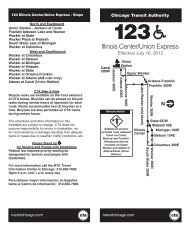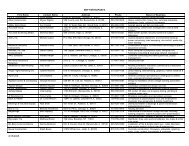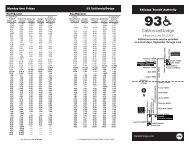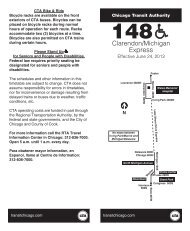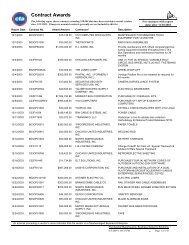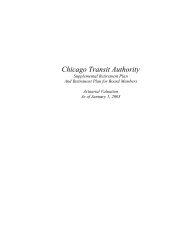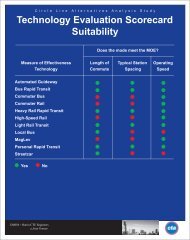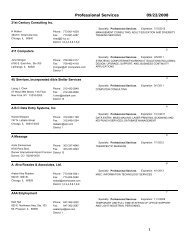Table Of Contents - Chicago Transit Authority
Table Of Contents - Chicago Transit Authority
Table Of Contents - Chicago Transit Authority
Create successful ePaper yourself
Turn your PDF publications into a flip-book with our unique Google optimized e-Paper software.
CTA Express Airport Train Service Business Plan<br />
standpoint, it would allow the dedicated Express cars to be phased into service alongside the Dedicated<br />
Service fleet (though this could be done under most any transition scenario).<br />
Regarding the phase-in of the dedicated Express cars, it is possible that once the prototypes have been<br />
accepted, these cars could be introduced to the peak period services to/from O’Hare, with successive<br />
deliveries being assigned to other trips to the point that the transition to full operation with the new cars<br />
is accomplished.<br />
6.1.3 Key Assumptions<br />
Adherence to existing CTA operating practices with regard to, among others, layover times, use of dropback<br />
train operators, etc., were basic factors considered in the development of the operating plan. In<br />
addition, current union agreements were reflected in the staffing plan. It is possible that with contract<br />
operations, some aspects of this situation might change.<br />
Minimum desirable headways between future Express Service trains and existing demands for train<br />
service on the Blue, Orange, and Red Lines were a major concern as the schedule was developed. While<br />
the assignment did not include simulation of operations, it quickly became apparent that manual analysis<br />
of peak period operations for both the shared Blue Line and dedicated express alignment operations were<br />
essential in determining the workability of the proposed operations. These analyses could only be done<br />
for the peak-of-the-peak, but they showed the extent of potential delays to both the express and local<br />
trains, as leader trains were caught and then overtaken. The results of these exercises demonstrated the<br />
need to ultimately conduct computer-based simulations of the intermixed operations through the State<br />
Street Subway and on the south side elevated in particular.<br />
6.1.4 Operating Complexities<br />
A number of complexities exist that could effect the operation of the airport train service. These risks<br />
include:<br />
• Travel time and headway - Short dwell and layover times for peak period Express Service trains may<br />
limit operational flexibility.<br />
• Delays to local trains - During peak periods, Express Service train journeys to/from O’Hare may<br />
regularly take up to five minutes longer than during non-peak periods on the Blue Line Elevated<br />
alignment.<br />
• Delays to Express trains - The manual operations analyses indicated that the peak period Express<br />
Service trains on the Blue Line Elevated alignment may actually take greater delay than they cause to<br />
local trains. This is due to having to run slow after catching the leading train, waiting for<br />
signals/switches once the local is in the clear, etc.<br />
• Increased demand for local CTA services - Systemwide, rail ridership has been increasing steadily for<br />
more than ten years. The O’Hare Branch of the Blue Line, the Red Line, and the Orange Line have<br />
all been experiencing ridership growth, making peak period track space a more limited resource.<br />
• Acceptability of contract-operations by unionized CTA employees – CTA’s current collective bargaining<br />
agreement with Amalgamated <strong>Transit</strong> Union Local 308 prohibits the outsourcing of train operations,<br />
repair, and switching.<br />
52





